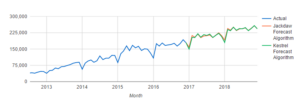Dave Salisbury shares his advice for running a great call monitoring programme in the contact centre.
What is the worth of a hammer; the value of the tool is not found with the device itself but in the skilled hands of the craftsman who is wielding the hammer and creates.
The hammer knows nothing, does nothing, and can only be used by someone. The person wielding the hammer receives all the glory or all the shame for how the tool was used, this is the natural order of a tool.
“You cannot teach a man anything. You can only help him discover it within himself.” ~ Galileo Galilei
Call monitoring is akin to the hammer. In skilled hands, with the support of organisational intent, purpose, and with the need to fill goals, call monitoring can create a workforce to envy all others. In skilled hands, lacking a purpose, bereft of intent, and with the only reason to punish, call monitoring becomes the tools of despots to control the fate of others.
My intent is to build other skilled hands, who can claim the tool of call monitoring, employing it carefully, and thus build a stronger, more resilient, and flexible call centre, capable of meeting the demands of tomorrow, using the people of today, to shape the call centre industry.
What is the purpose of call monitoring, to build or bully? That question forms the core around which the rest of this article hinges. Like the hammer, call monitoring can do nothing of its own will. Yet, the purpose of a tool is found in the intent of the owner, build or destroy.
Granted, destroying has a purpose, but is a person remembered for how well they demolished or how well they built?
When the intent is known, the meaning is clear; when the purpose is clear, the actions of the call monitors become discernible; once discerned, the employee is either harmed or built professionally.
I can tell the type of call centre I am tasked with consulting, by asking front-line agents about the call monitoring they receive. If call monitoring occurs, or not, the front-line agent will be equipped to:
- Know, and be motivated to share, all they like or dislike about call monitoring
- Gather a random sample
- Combine their opinions with other members of the team to form a group consensus
If you ask agents to do these things, actions of the call centre management team can be more easily discerned than any other report, measurement or reporting tool.
Why? because the soul of a call centre is developed in how the tool, call monitoring, is implemented.
Some have asked; what does call monitoring do? Quite simply, call monitoring records behaviours.
Yes, words are used, but words are an ambiguous measurement of an agent. The agent’s attitude, mental condition, training value and so much more flows from call monitoring as the behaviour.
With this in mind, call monitors should never be tasked with listening to words, as specific verbs and adjectives do not relate or reflect the behaviour of the agent.
Reflectively listening for the behaviour is how you measure adherence to organisational controls, and this is the job of call monitors.
Who should be call monitors? The answer is both simple and complex.
The individual agent should be the first line of evaluation for call monitoring. Humans judge themselves most harshly, and the wise supervisor or team leader will use self-evaluation of calls to the benefit of the agent.
Next, the peers of the agent, those members on the same team, form the second layer of call monitors. This allows peers to learn, comment, and share experiences, ideas, tips and tricks, which empowers all the agents on the team to work together to improve individual performance.
The third layer is those in quality assurance which can provide an outside opinion on agent performance.
The fourth layer is managerial in nature, dependent upon the organisational hierarchy, and most controlled by the mission, purpose, and goals of the organisation.
Each layer has strengths and weaknesses, opportunities, and potential, harnessing the power of each layer requires both data and leadership.
Data is often collected on forms. However, if the documents are only collecting quantitative data, the why behind the score is missed, as well as the opportunity to understand and correct.
Yet, if the data on the forms is all qualitative in nature, then many managers will never read the comments. This ruins much potential, because the manager will complain about time loss and complexity.
Both qualitative and quantitative data are subjective in nature, requiring a review and an appeal process to ensure the tool (call monitoring) has not become a whipping post to browbeat and demoralise agents.
While qualitative data will be explanatory in nature, the quantitative scores must be explainable, fair, timely, and provide value to the agent receiving the scores. Never allow an opportunity to pass without issuing praise, recognising efforts and preparing the agent to change and grow professionally.
Calls can be monitored in a myriad of ways, below are a few most commonly found.
| Types of Call Monitoring | |||
|---|---|---|---|
| Method | Meaning | Strengths | Weaknesses |
| Recorded Calls | Software records calls for playback at a future time |
|
|
| Side-by-Side | Two sets of headsets, where a senior person and a junior person can sit together and begin to learn. |
|
|
| Peer-to-Peer | Can be real-time or recorded. Designed to strengthen agents to new levels of performance. |
|
|
| Ghosting | Where call monitors/QA professionals can listen into a call, comment on one channel with the agent where the customer cannot hear the coach |
|
|
| Call Reviews | Occurs offline, generally by a call monitor/QA professional, supervisor, team leader to review a series of calls made by an agent |
|
|
Key to understanding how to monitor calls is when to monitor and why an agent is being monitored.
Daily team huddles are a perfect opportunity to discuss a common mistake heard on the production floor, to recommend group-wide behaviour modification or to encourage agents as a team with hearing an example call.
Weekly and monthly team meetings provide an opportunity to showcase greatness for the team.
Weekly and monthly one-on-one sessions can address specific behaviors to correct, offer praise, and work individually with team members.
Semi-annual and annual gatherings provide management space and time to broadcast “Best in Class” calls, high performers, and motivate the call centre agents.
The best call monitoring can ever do, is to enhance training. Call monitoring does not replace quality control mechanisms; but remains only a small part of the QA strategy, in the hands of risk managers and operational leaders.
Call monitors should never be punishers of people, police used to catch wrongdoing, or the secret police threatening agents in the background as a snitch for management.
As a point of import, call monitoring, and HR driven punishment should be separated, even when the behaviour was discovered during call reviews.
So, if you want to better call monitoring, model the behaviours you want to see in agents:
- If you reflectively listen to the agent, the agent will reflectively listen to the customer on the phone
- If you smile when communicating, your agents will smile when communicating
- Want to hear please, thank you, and you’re welcome, use these phrases frequently
- Need your agents to like your customers, praise your agents publicly and reprimand gently in private
The behaviour of leadership is the best tool for improving call monitoring performance.
Please note, nothing ever happens without practice. Never take your customer, or allow an agent to lead a customer, where you, or the agent, have not already traveled mentally. Encourage the agents to practice best business practices to enhance call performance.
Modeling is crucial, but don’t hesitate to discuss how you practice the behaviours you are modeling.
If you had to learn something, talk about that learning experience; when did you practice? How long did it take to master? Are you still learning and improving your own performance?
Finally, never stop learning something new and talking about what was learned. Learning is a behaviour, model accordingly!
Since call monitoring is a tool, there should be a sound strategy driving the tactical actions of those monitoring calls. Every agent, supervisor, manager, team lead, and agent should be able to both specify the reason why call monitoring exists, and how their individual actions improve call monitoring strategies.
Key performance indicators (KPI’s) survive only because a manager claims that particular metric is vital to the overall health of the business in general and the call centre specifically.
Yet, if a KPI cannot be easily explained, and a front-line agent able to detail why that measurement is taken, and what actions drive performance improvement in that KPI, then the KPI has no value.

Dave Salisbury
KPI’s are a tool similar to call monitoring; thus, it behooves the organisational leadership team to equip each agent with the why behind call monitoring, the how call monitoring works and helps the agent and builds enthusiasm for the call monitoring program.
Never forget to model that which you want to see as a behaviour in the call centre. Never allow the strategy and tactical actions in call monitoring to become stale. Detail the why behind actions taken to build enthusiasm, and real change occurs. Know the intent of the process to ensure the strategy and tactical operations align.
Thanks to Dave Salisbury, an Operations and Customer Relations Specialist, for putting this article together for us. Catch him on the following Webinar: Call Monitoring Strategies
Author: Dave Salisbury
Reviewed by: Jonty Pearce
Published On: 13th Mar 2019 - Last modified: 26th Feb 2025
Read more about - Expert Insights, Dave Salisbury















